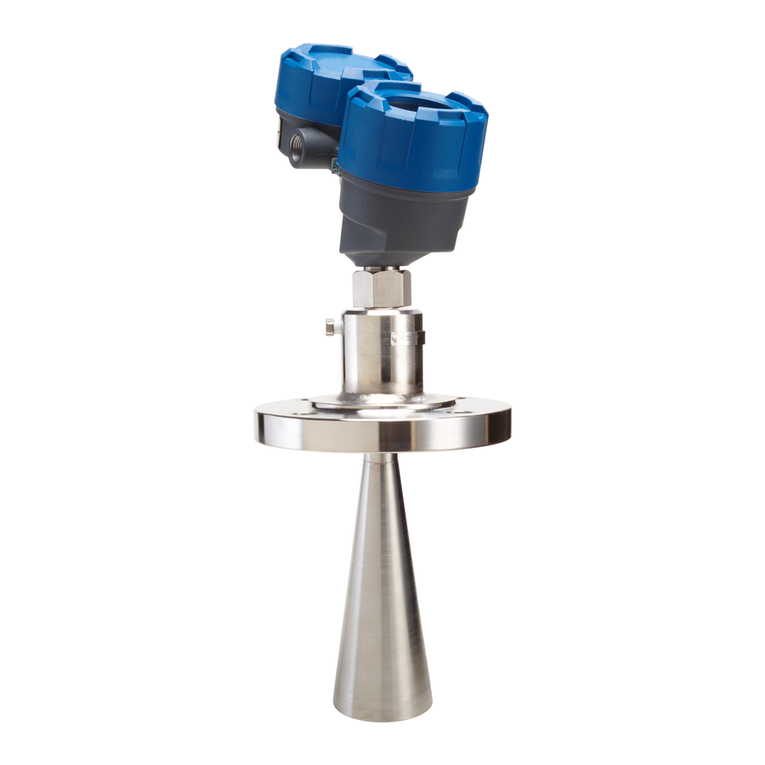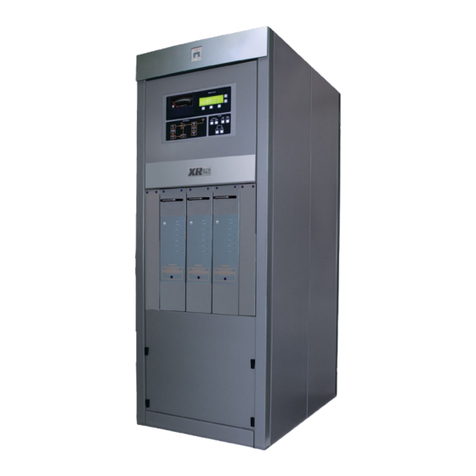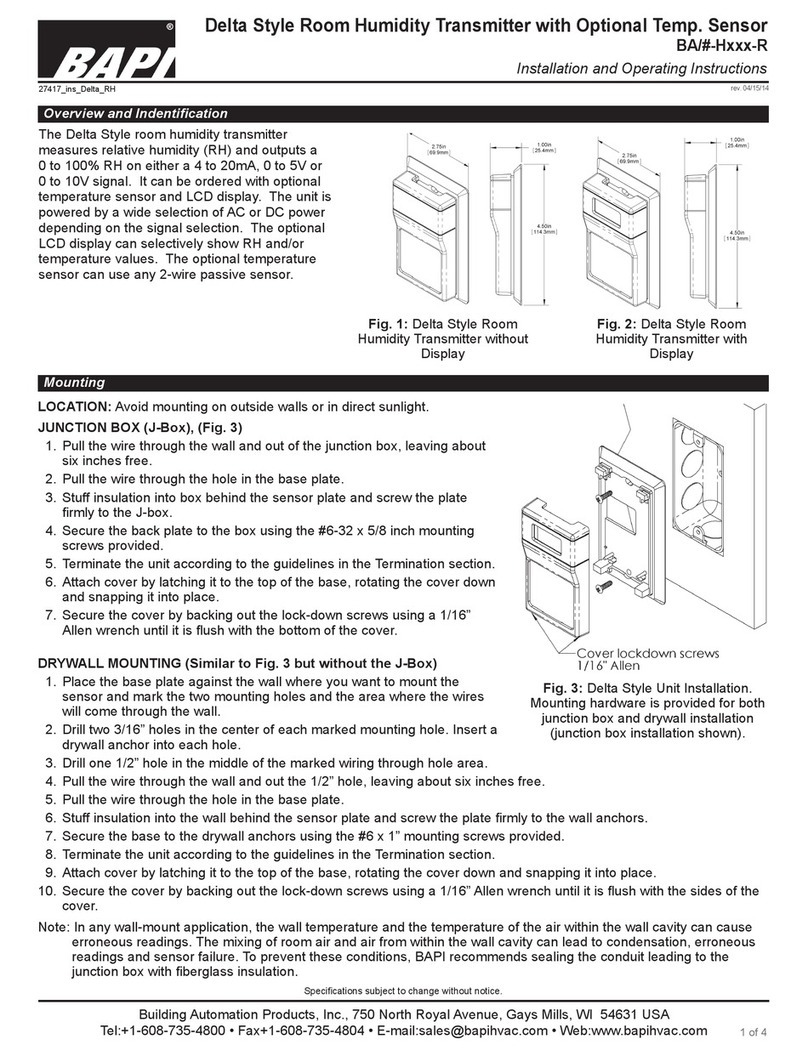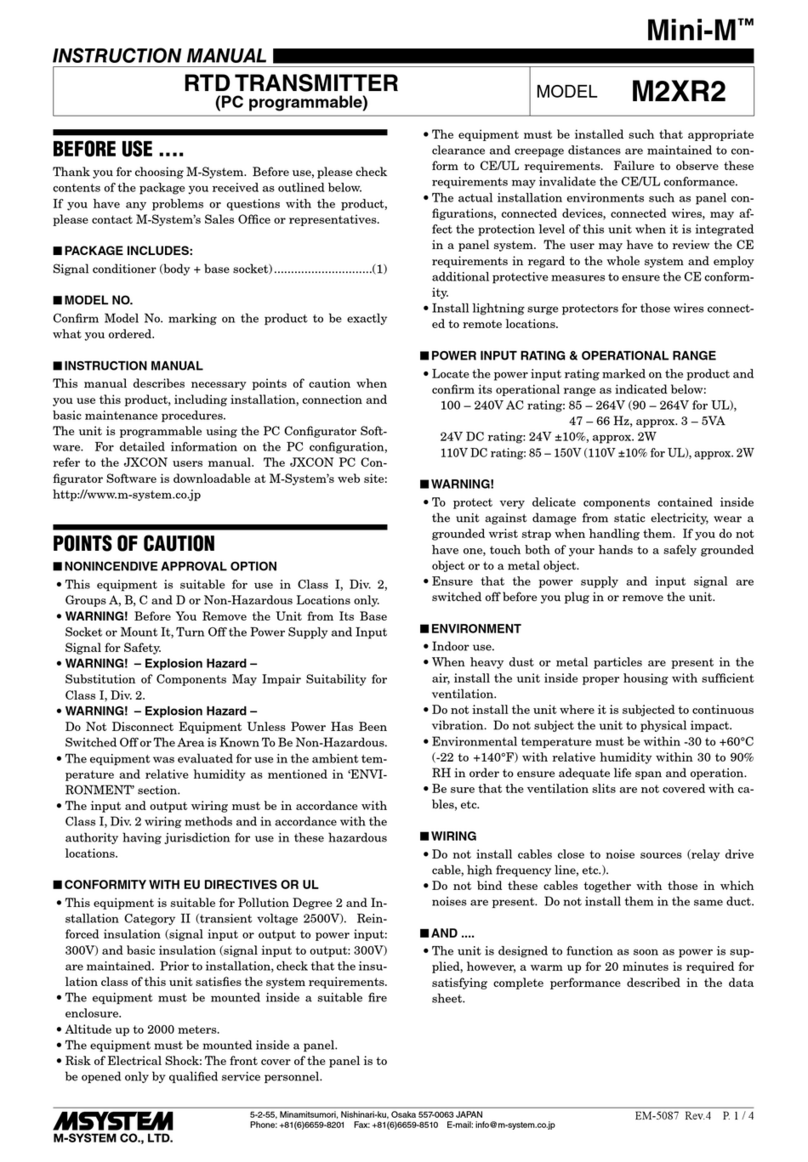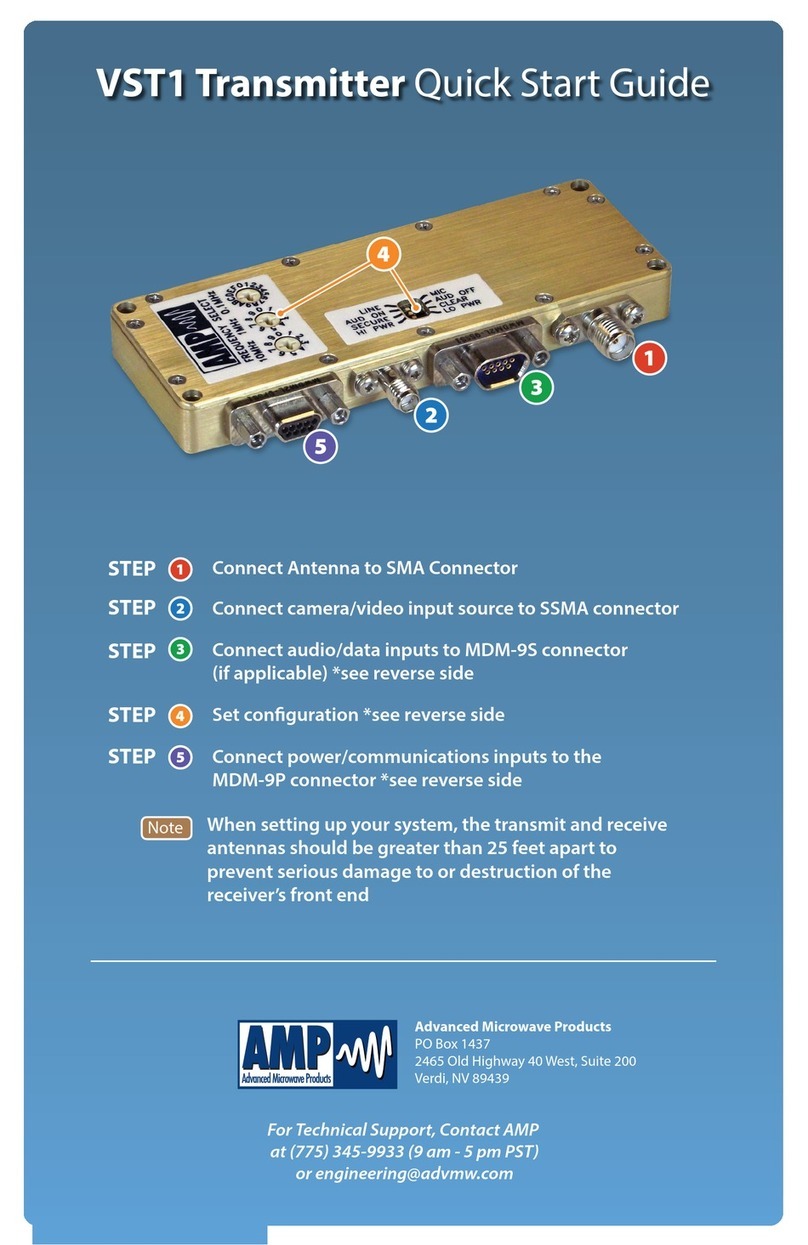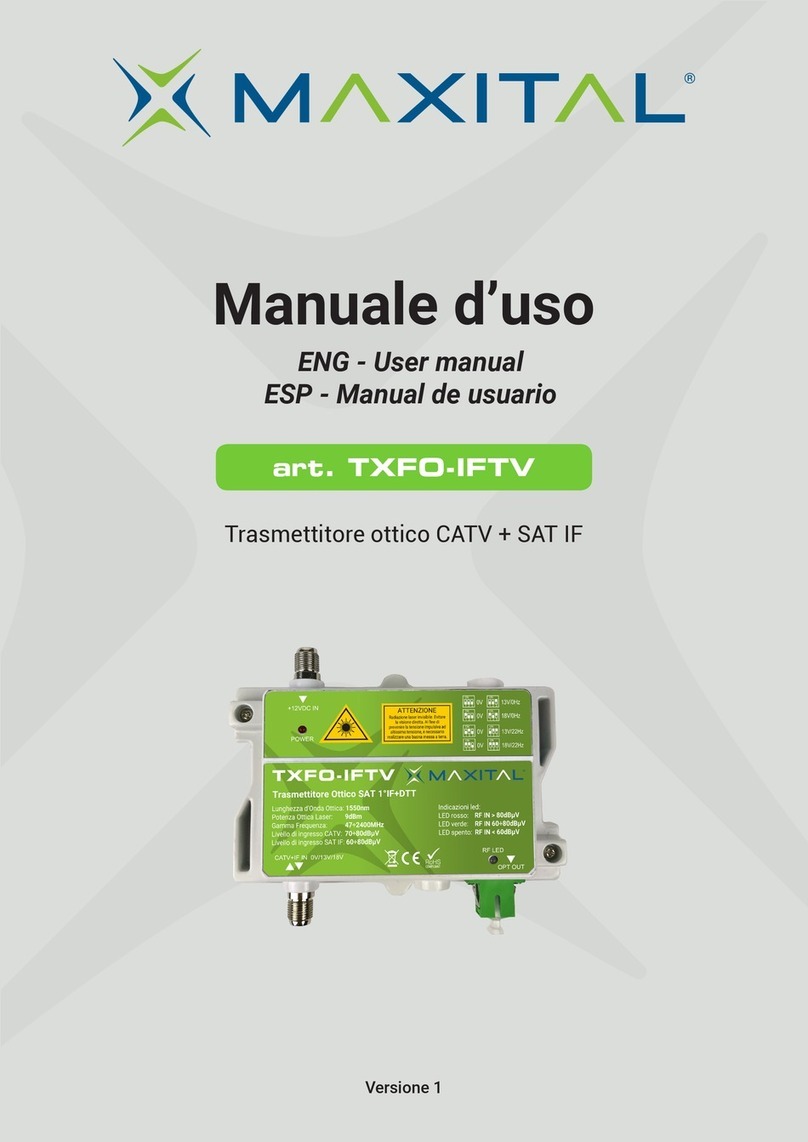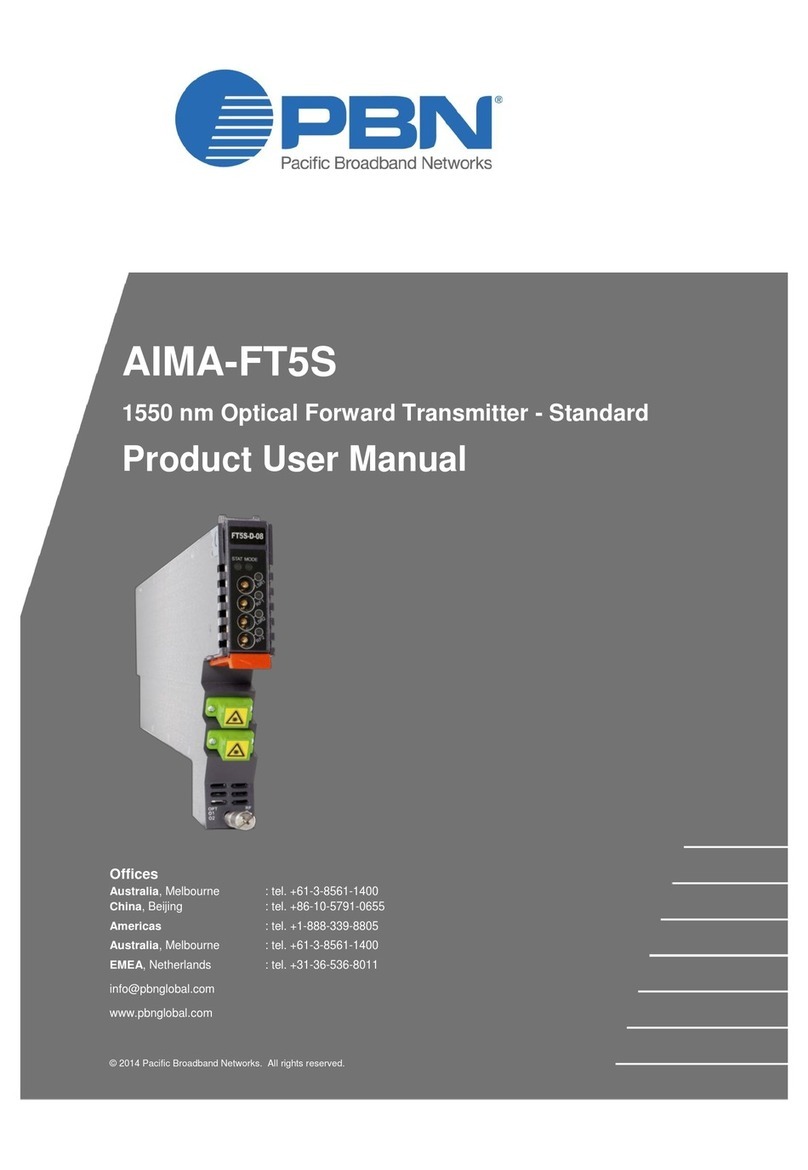Larson Electronics EPSW-TS-RTD-6P-R1 User manual

EPSW-TS-RTD-6P-R1
Larson Electronics, LLC Phone: (800) 369-6671 Fax: (903) 498-3364 www.larsonelectronics.com 1of 5
Explosion Proof RTD Temperature Transmitter
Class I, II, III - 6" Probe - ATEX/IECEx - N4X
Instruction Manual
Thank you for your purchase of the Larson Electronics EPSW-TS-RTD-6P-R1.
\
WARNING:
READ CAREFULLY BEFORE INSTALLING FIXTURE. RETAIN THESE INSTRUCTIONS FOR FUTURE REFERENCE.
CRITICAL SAFETY INSTRUCTIONS:
•INSTALLATION SHOULD ONLY BECONDUCTED BY A QUALIFIED ELECTRICIAN IN ACCORDANCE WITH NEC AND ANY
RELEVANT LOCAL BUILDING CODES.
•RISK OFFIRE OR ELECTRIC SHOCK. FIXTURE INSTALLATION REQUIRES KNOWLEDGE OF FIXTURE'S ELECTRICAL
SYSTEMS. IFNOTQUALIFIED, CONTACT A QUALIFIED ELECTRICIAN.
•BE CERTAIN ELECTRICAL POWER IS OFF BEFORE AND DURING INSTALLATION AND MAINTENANCE.
•MAKE SURE THE SUPPLY VOLTAGE IS THE SAME AS THE FIXTURE'S RATED VOLTAGE.
•TO PREVENT WIRING DAMAGE OR ABRASION, DO NOT EXPOSE WIRING TO EDGES OF SHEET METAL OR SHARP
OBJECTS. SUITABLE FOR DAMP LOCATIONS.
WARNING
TO AVOIDTHE RISKOF FIRE,EXPLOSION OR ELECTRIC SHOCK, THIS PRODUCT SHOULD BE INSTALLED,
INSPECTEDAND MAINTAINEDBY A QUALIFIED ELECTRICIANONLY, IN ACCORDANCEWITHALL
APPLICABLEELECTRICAL CODES.
TO AVOIDELECTRIC SHOCK:
•BE CERTAIN ELECTRICAL POWER IS OFF BEFORE AND DURING INSTALLATION AND MAINTENANCE.
•PRODUCT MUST BE CONNECTED TO A WIRING SYSTEM WITH AN EQUIPMENT-GROUNDING
CONDUCTOR.
TO AVOID EXPLOSION:
•MAKE SURE THE SUPPLY VOLTAGE IS WITHIN THE VOLTAGE RATING.
•ENSURE THE MARKED T RATING IS LESS THAN THE IGNITION TEMPERATURE OF THE HAZARDOUS
ATMOSPHERE.
•DO NOT OPERATE IN AMBIENT TEMPERATURES ABOVE THOSE INDICATED ON THE PRODUCT
NAMEPLATE.
•DO NOT OPERATE IF THE LENS, CORD, SEALS, HOUSING, RECEPTACLES, ETC. IS CRACKED OR
DAMAGED. IF SO, DISCONTINUE USE AND CONTACT MANUFACTURER FOR REPLACEMENT PARTS.
•ALL FASTENERS SHOULD BE PROPERLY SEATED.
The EPSW-TS-RTD-6P-R1 from Larson Electronics is an Explosion Proof RTD Temperature Transmitter for Class I, II
and III rated locations. This low voltage unit contains a 6" stem/probe and features an LCD display. Protected by a NEMA
4X rated 316 stainless steel housing, the transmitter offers seven pre-programmed temperature ranges.
WIRING
Standard pigtail(flying leads) wiring
We strongly encourage a licensed electrician install this product,in all locations especially in outdoor areas
where weatherproofing may be required. Universal voltage driver permits operation at 10V - 35V DC.
Warning: Check product label for correct input voltage!
Attach supply line wires to the appropriate light fixture wires as shown
in thediagram
Secure each pair of wires according to the diagram. Utilize a junction box or
similar device and take precautionary steps for weatherproofing all
connections if installed in a location where water may come in contact with the
unit. Ensure the unit is properly grounded and that wiring is done according to
all local and national electrical/building codes.

EPSW-TS-RTD-6P-R1
Larson Electronics, LLC Phone: (800) 369-6671 Fax: (903) 498-3364 www.larsonelectronics.com 2of 5
Low Voltage DC
Connect power to power supply outputting low voltage between 10-35 Volts
DC. This variable voltage allows greater versatility without affecting light output.
Ensure deutsch connectors are properly connected (If applicable)
HUBS
The EPSW-TS-RTD-6P-R1 contains one 1/2" male NPT hub for process connections
and one 1/2" female NPT hub for conduit connections.
INSTALLATION
1. Location: Select a location where the temperature of the transmitter will be between -4 and 158°F. Distance from the
receiver is limited only by total loop resistance.
2. Position: The transmitter is not position sensitive. Units with the optional display should be mounted for ease of
viewing the display.
3. Electrical Connection: Wire Length - The maximum length of wire connecting the transmitter and receiver is a
function of wire size and receiver resistance. Wiring should not contribute more than 10% of the receiver resistance to
total loop resistance. For extremely long runs (over 1000 feet), choose receivers with lower resistance to minimize the
size and cost of connecting leads.
Current (4-20 mA) Output Operation
An external power supply is required. See Figure A for diagram of the connection of the power supply, transmitter and
receiver. The range of appropriate receiver load resistance (RL) for the DC power supply voltage available is expressed
by the formula:
RL = Vps – 10
20 mADC
Shielded cable is recommended for control loop wiring.
- RECEIVER +
mA
1
2
3
4
5
6
POWER
SUPPLY
10-35 VDC
RTD
TRANSMITTER
+
-
Figure A
FM Explosion-Proof Installation Notes:
1. Install in accordance with any applicable national electric code.
2. Plug unused conduit openings. Plug must engage a minimum of 5 threads.
3. Use a conduit seal within 18 inches of conduit entry.
4. Disconnect power before servicing.
Electrical connections to the RTD Transmitter are made to the terminal block located inside the housing. Unscrew and
remove the cover. Wire as shown in Figure B.

EPSW-TS-RTD-6P-R1
Larson Electronics, LLC Phone: (800) 369-6671 Fax: (903) 498-3364 www.larsonelectronics.com 3of 5
Temperature Range Selection
The RTD Transmitter has 7 built in temperature ranges and a user settable range that are selectable by setting the
Dip Switch located inside the housing (Figure C). Switches 2, 3, and 4 are used to set the range. To set the desired
range, unscrew and remove the cover and set the Dip Switch according to the following table:
Selectable Ranges
Dip Switch
234
40 to 90°F (4.4 to 32.2°C)
-20 to 140°F (-28.9 to 60°C)
0 to 100°F (-17.8 to 37.8°C)
30 to 240°F (-1.1 to 115.6°C)
32 to 212°F (0 to 100°C)
32 to 122°F (0 to 50°C)
-30 to 65°C (-1.1 to 18.3°C)
User ettable
OFF
ON
OFF
ON
OFF
ON
OFF
ON
OFF
OFF
ON
ON
OFF
OFF
ON
ON
OFF
OFF
OFF
OFF
ON
ON
ON
ON
Setting and Calibrating the User Settable Range
By setting SWITCH 2, 3, and 4 on, the RTD Transmitter may be adjusted to a custom user specified range. The range
may be any values between –30°F and +250°F (-34 to +121°C) with a MINIMUM SPAN of 40°F (22°C).
Equipment Required
In order to calibrate the unit for a custom range, a precision RTD simulator that can simulate a 1000 OHM DIN type RTD
or precision decade box is required. The device must be capable of generating the correct RTD resistance to 0.1% or
better.
Calibration Procedure
1. Set DIP SWITCHES 2, 3 and 4 ON.
2. Remove the RTD sensor leads from terminals 5 and 6 (Figure B). Connect the precision RTD simulator or
decade box to terminals 5 and 6.
3. Wire instrument as previously discussed. A current meter may be wired in series with the unit to verify the correct
current output, but this is not necessary for calibration. Apply power to the unit.
4. If a precision RTD simulator is used, make sure it is set to simulate a 1000 OHM DIN 0.00385 RTD. Then set it to the
desired minimum temperature. If a decade box is used refer to the table in Appendix A (°F) or Appendix B (°C) and set
it to the resistance that represents the desired minimum temperature.
5. Press the ZERO button. If the unit has the optional LCD, the display will read ZERO OK momentarily. If a current meter
is wired, it will read 4.00 mA.
6. Repeat step 4 using the value for the maximum desired temperature.
7. Press the SPAN button. If the unit has the optional LCD, the display will read SPAN OK momentarily. If a current meter
is wired, it will read 20.00 mA.
8. Turn off power to the unit. Disconnect the RTD simulator or decade box and reconnect the RTD sensor to terminals 5
and 6. Calibration is complete.
Note: The calibration procedure does not effect the calibration of any of the built in ranges.
°F and °C Selection
If the unit has the optional LCD display, DIP SWITCH 1 sets the display to read in °F or °C. SWITCH 1 “OFF” = °F
SWITCH 1 “ON” = °C.
Output Current Display
If the unit has the optional LCD display, the lower display will show the output current if DIP SWITCH 5 is “ON”. Setting
DIP SWITCH 5 “OFF” causes the lower display to be blank.
Open RTD Protection
Upon detecting an open RTD, the unit may be set to force the output to read 3.5 mA or 21mA based upon the setting of
DIP SWITCH 6.
SWITCH 6 “OFF”, output forced to 3.5 mA
SWITCH 6 “ON”, output forced to 21 mA

EPSW-TS-RTD-6P-R1
Larson Electronics, LLC Phone: (800) 369-6671 Fax: (903) 498-3364 www.larsonelectronics.com 4of 5
Calibration
The unit requires no calibration. An internal precision resistor continually self calibrates the unit. Calibration may be verified
by removing the sensor leads and testing the unit against a precision RTD simulator or a precision decade box. If the unit
is found to be out of calibration it must be returned to the factory for service.
ELECTRICAL CONNECTIONS
Connect wire leads in accordance with local electrical codes. For units supplied with both internal ground and
external bonding terminals, the ground screw inside the housing must be used to ground the control. The external
bonding screw is for supplementary bonding when allowed or required by local code. When external bonding
conductor is required, conductor must be wrapped a minimum of 180° about the external bonding screw. See below.
FRONT VIEW DETAIL
BOTTOM VIEW DETAIL
CLAMP
PLATES
LOCKWASHER
SCREW
CONDUCTOR
EU-Type Certificate, IECEx Installation Instructions:
Cable Connection
The cable entry device shall be certified in type of explosion protection flameproof enclosure “db”, suitable for conditions
of use and correctly installed. For ta ≥ 70°C cable and cable gland rated ≥ 75°C (MIN.) shall be used.
Conduit Connection
An Ex db certified sealing device such as a conduit seal with setting compound shall be provided immediately to the
electrical entrance of the transmitter housing. For
ta ≥ 70°C wiring and setting compound, in the conduit seal, rated ≥ 75°C shall be used.
Unused entries shall be sealed with an Ex certified blanking device rated for the appropriate zone, equipment group
and temperature classification and shall be installed per manufacturer instructions.
Note: For ATEX/IECEx units only: When employed in a Zone 1, EPL Gb (db) application, the temperature class is
determined by the maximum ambient and or process temperature. Units are intended to be used in ambient of -20°C≤
Tamb ≤70°C. Units may be used in process temperatures up to 120°C providing the enclosure temperature do not
exceed 70°C. The standard Temperature Class is T6 Process Temp ≤80°C. Remaining temperature classes are,
Temperature Class of T5 Process Temp ≤95°C and Temperature Class T4 Process Temp ≤ 120°C. Refer to Certificate
No: Element IECEx EMT17.0007X for conditions of safe use for IECEx compliant units. All wiring, conduit and enclosures
must meet applicable codes for hazardous areas. Conduits and enclosures must be properly sealed. For outdoor or other
locations where temperatures vary widely, precautions should be taken to prevent condensation inside enclosure.
Electrical components must be kept dry at all times.
When employed in a Zone 20, EPL Da (ta) application, the equipment is to be used with a power source rated for a
prospective short circuit current of 10 kA. If the power source is rated for a prospective short circuit current of less than
10 kA, the end user or installer must mark the equipment with the prospective short circuit current rating of the power
supply it is used in conjunction with.

EPSW-TS-RTD-6P-R1
Larson Electronics, LLC Phone: (800) 369-6671 Fax: (903) 498-3364 www.larsonelectronics.com 5 of 5
MAINTENANCE
Inspect and clean wetted parts at regular intervals. The cover should be in place at all times to protect, the internal
components from dirt, dust and weather and to maintain hazardous location ratings. Disconnect device from the supply
circuit before opening to prevent ignition of hazardous atmosphere. Repairs to be conducted by Dwyer Instruments,
Inc (field repair should not be attempted and may void warranty).
Units in need of repair should be returned to the factory prepaid. Be sure to include a brief description of the problem plus
any relevant application notes. Contact customer service to receive a return goods authorization number for shipping.
Repairs to electrical connection, process connection and flameproof joints are prohibited to maintain safe
use of the product.
WARNING
To prevent ignition of hazardous atmospheres, disconnect the device from the supply circuit before
opening. Keep assembly tightly closed when in use.
CAUTION
USE AND CARE
Unauthorized modification may impair the function and/or safety of this device and could affect the life of the equipment.
Always check for damaged or worn out parts before using the device. Store it in a secure place out of the reach of
children when not in use.Inspect for good working condition prior to storage and before re-use.
REPLACEMENT PARTS
The EPSW-TS-RTD-6P-R1 is designed to provide years of reliable performance. Should the need for replacement parts
arise, please contact Larson Electronics.
THESE INSTRUCTIONS MAY NOT COVER ALL DETAILS OR VARIATIONS OF THIS PRODUCT FOR YOUR EQUIPMENT OR INSTALLATION REQUIREMENTS.
SHOULD FURTHER INFORMATION NOT COVERED BY THESE INSTRUCTIONS BE REQUIRED, PLEASE CONTACT LARSON ELECTRONICS BY EMAIL AT
SALES@LARSONELECTRONICS.COM OR BY PHONE AT 1-800-369-6671 FOR FURTHER ASSISTANCE.
PLEASE VISIT LARSONELECTRONICS.COM FOR WARRANTY AND RETURN INFORMATION.
Table of contents
Popular Transmitter manuals by other brands
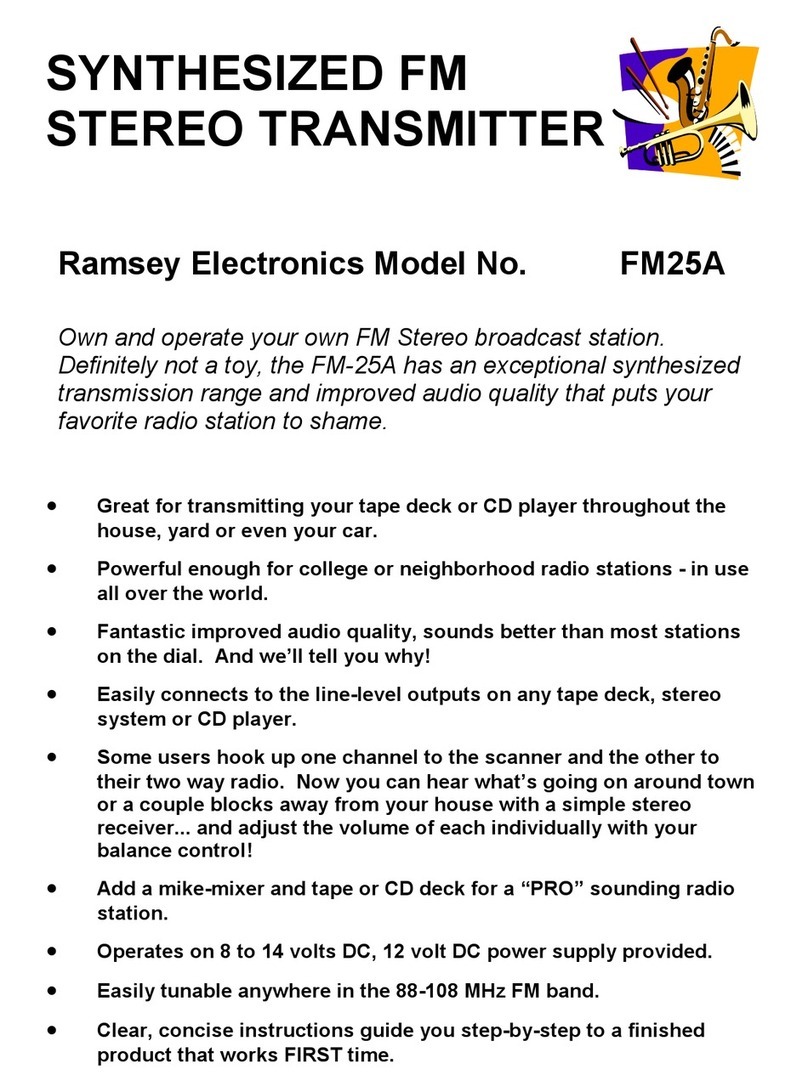
Ramsey Electronics
Ramsey Electronics FM25A Assembly and instruction manual
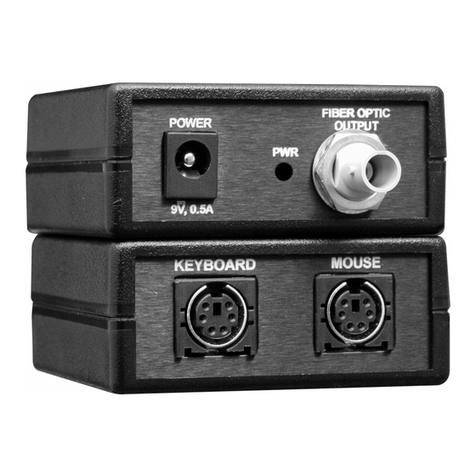
Altinex
Altinex DA1935KM user guide
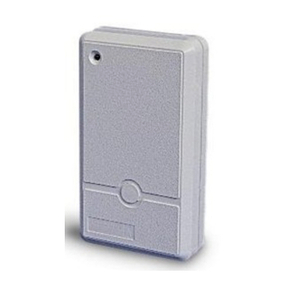
Visonic
Visonic WT-100 installation instructions
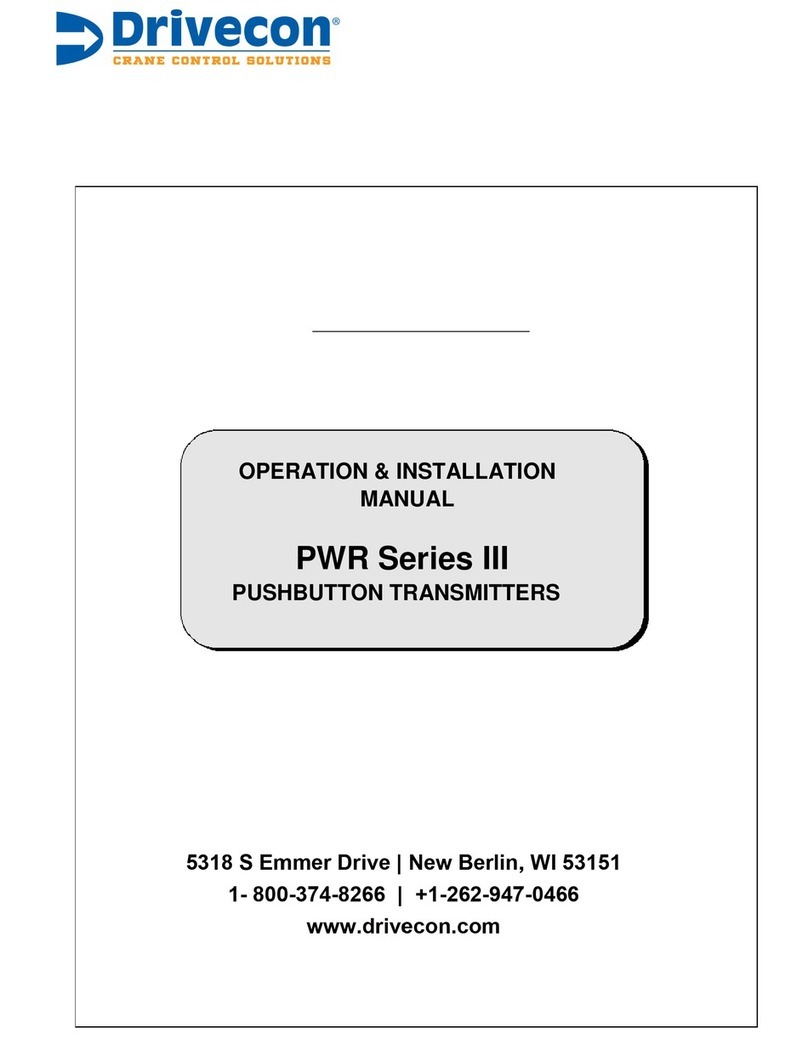
Drivecon
Drivecon PWR III Series Operation & installation manual
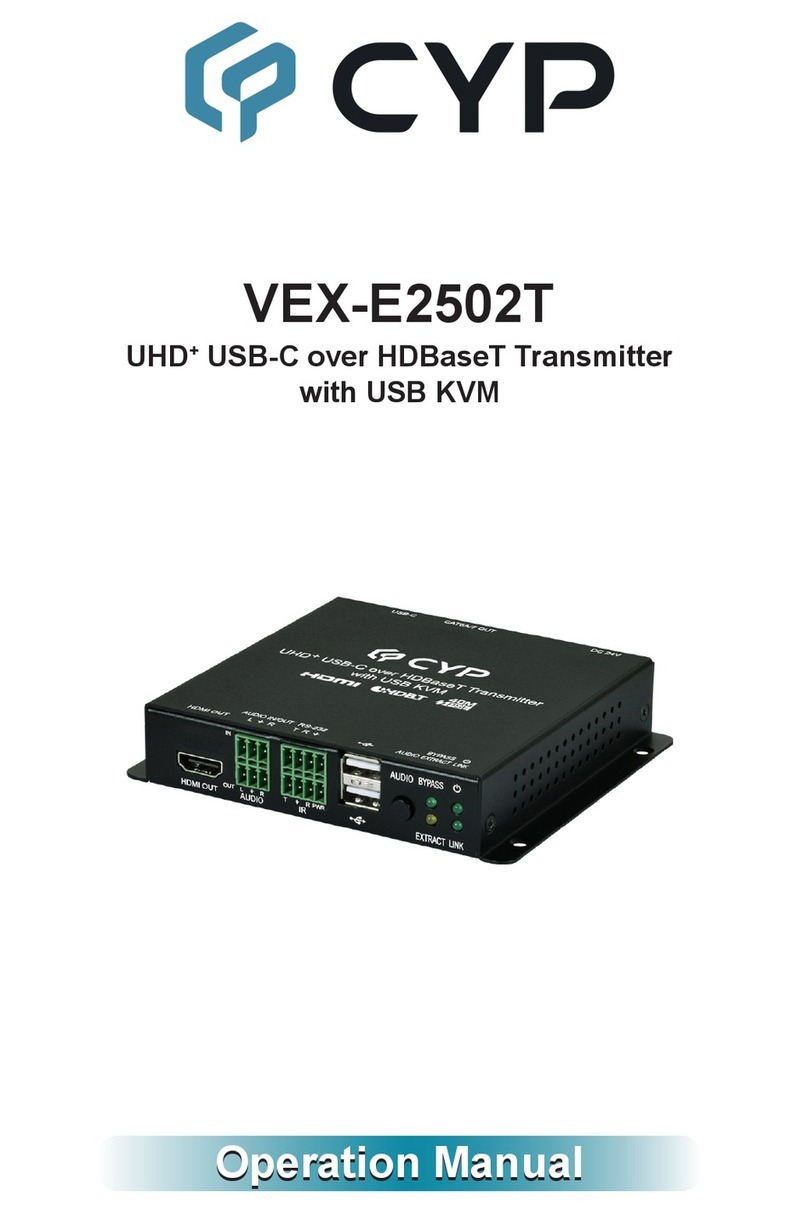
Cypress
Cypress VEX-E2502T Operation manual

Emerson
Emerson Rosemount 2051 quick start guide
